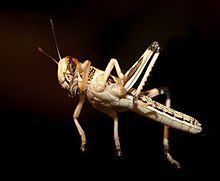User:Roccostrangio/2019–2021 locust infestation
Causes[edit][edit]
See also: Desert locust § Ecology and swarming

When periods of heavy rainfall follow periods of relative drought, solitary desert locusts emerge to feed on new-growth foliage and lay eggs in the newly moist soil, which prevents them from drying out. The sight and smell of other locusts, as well as sensory stimulation from contact between locusts' hind legs, precipitates changes in the locusts' behaviour and morphology; the previously green, nocturnal and solitary creatures become larger, develop black-and-yellow colouring, and begin to seek out other locusts, a process known as gregarization. These changes result in the formation of large locust swarms that gregarize nearby locusts and breed profusely, allowing them to undergo rapid, exponential growth. The swarms proceed to feed on the newly abundant vegetation, making use of improved swarm coordination, the result of larger brain sizes, as well as increased range, the result of increased metabolic activity, larger muscles, and longer wings, to travel up to 130 km a day in search of new vegetation and moist weather, often propelling themselves by the wind.
This particular desert locust plague traces back to May 2018, when Cyclone Mekunu passed over a vast, unpopulated desert on the southern Arabian Peninsula known as the Rub' al Khali, filling the space between sand dunes with ephemeral lakes, which allowed locusts to breed undetected. This was exacerbated in October 2018 by Cyclone Luban, which spawned in the central Arabian Sea, moved westward, and rained out over the same region near the border of Yemen and Oman. The Indian Ocean Dipole, an irregular oscillation in sea surface temperatures between the western and eastern parts of the Indian Ocean, has increased in magnitude due to the effects of climate change. This shift has resulted in increased cyclone activity over the last decade in the Persian Gulf, previously home to very few cyclones, and is associated with flooding in countries along the western Indian Ocean, dry weather in the east, and bushfires in Australia.
The two cyclones created conditions conducive to mass locust reproduction, enabling three generations of locusts to breed over a nine-month period, which increased their number in the Arabian desert roughly 8,000-fold.
Preventive measures[edit][edit]
FAO said containing the plague will cost at least $138 million. So far, donors have pledged $52 million as of April 2020, $10m of which has come from the Bill and Melinda Gates Foundation. Failure means more hunger in a region already battered by conflict and climate shocks. Aerial and ground spraying combined with constant tracking of the swarms are viewed as the most effective strategies. But the travel restrictions during the COVID-19 pandemic have hindered the preventive measures.
In the winter breeding areas, control operations started in December 2018 in Eritrea and, to a lesser extent, in Sudan. They extended to Egypt and Saudi Arabia in January where they continued for several months before a further extension to spring breeding areas in Saudi Arabia (February–June), Iran (February–July) and Pakistan (March–July). Control operations were then undertaken in the summer breeding areas along both sides of the Indo-Pakistan border (May–February), Ethiopia (August onwards) and Yemen (July onwards). During the winter of 2019/2020, control was carried out along both sides of the Red Sea (November–March), the Horn of Africa (December–present) and southern Iran (November onwards). About 2.25 Mha had been treated by February 2020.

As of April 2020 Ethiopia was using five planes and Kenya six planes for spraying and four planes for surveying. But the Kenyan government says it needs 20 planes for spraying - and a continuous supply of the pesticide Fenitrothion. Kenya has trained more than 240 personnel from affected counties in monitoring of locust swarms. To help prevent and control outbreaks, authorities analyze satellite images, stockpile pesticides and conduct aerial spraying. The U.N. has allocated $10 million for aerial spraying.
At the Intergovernmental Authority on Development climate prediction and applications centre, based in Nairobi, researchers have been running a supercomputer model to predict breeding areas that may have been missed by ground monitoring. These areas could become sources of new swarms if not sprayed and create an upsurge. So if hoppers are stopped from adults this wouldn't lead to another cycle of infestation. The supercomputer, funded by £35m of UK aid as part of its Weather and Climate Information Services for Africa programme, has successfully forecast the movement of locusts using data such as wind speed and direction, temperature, and humidity. The model has achieved 90% accuracy in forecasting the future locations of the swarms.
Researchers are now inputting data on soil moisture and vegetation cover to help predict where eggs have been laid and are likely to hatch and thrive. This will then provide data on where African governments can direct their spraying efforts, helping to control the hoppers before they swarm. The Kenyan government is on high alert and effective control measures have been put in place.
The Chinese government announced in February it was sending a team of experts to neighbouring Pakistan to develop "targeted programmes" against the locusts and deploy 100,000 ducks.
